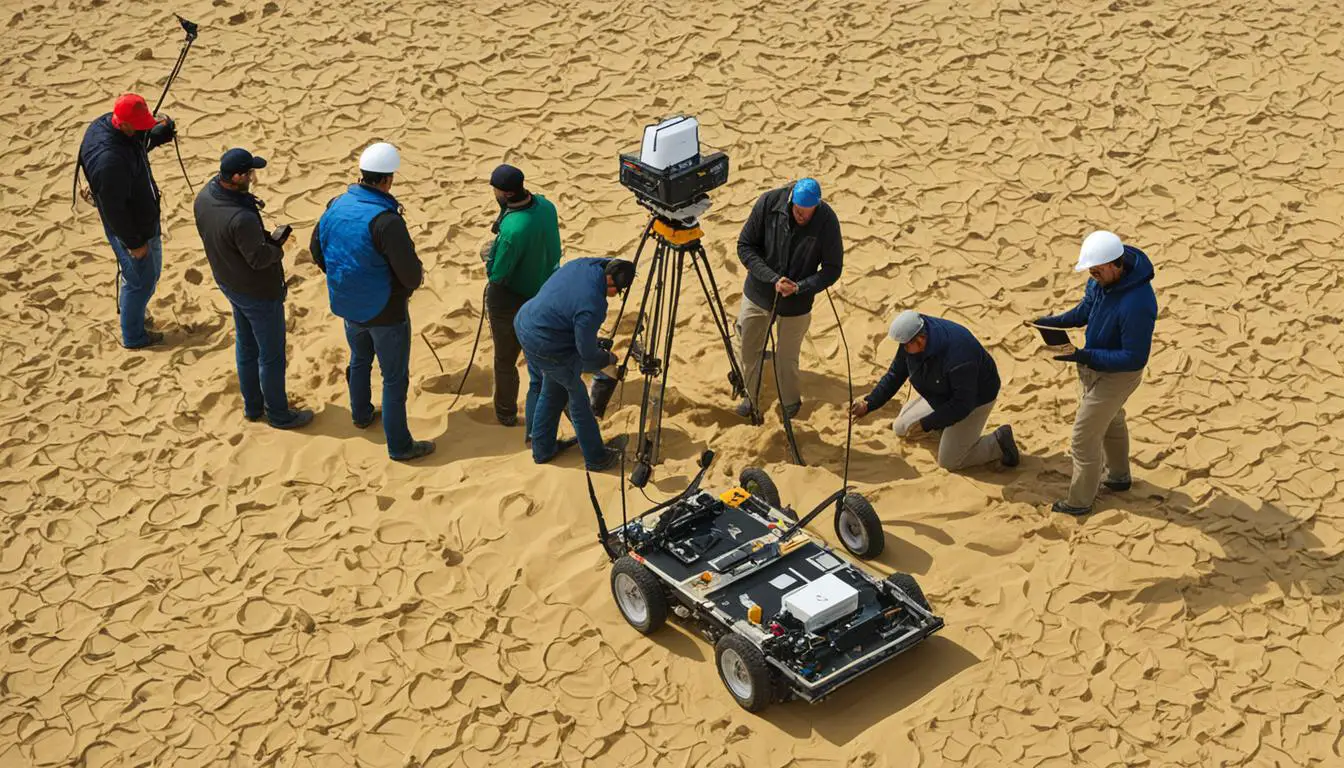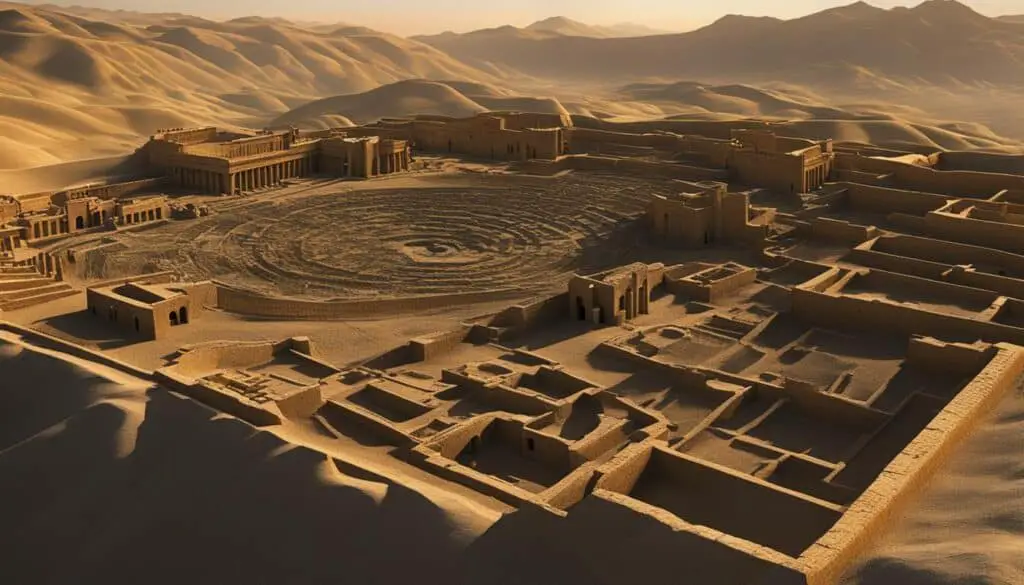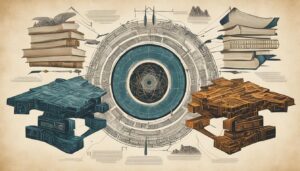
Ground-penetrating radar (GPR) is a powerful tool used in the field of biblical land studies to uncover hidden historical treasures and reshape our understanding of ancient civilizations. By sending electromagnetic waves into the ground and analyzing the reflected signals, GPR can create detailed images of underground structures, artifacts, and geological features. This technology has revolutionized archaeology and has been instrumental in uncovering important archaeological sites in biblical lands.
Key Takeaways
- Ground-penetrating radar is a valuable tool in biblical land studies.
- GPR uses electromagnetic waves to create images of underground structures and artifacts.
- It has revolutionized archaeology and led to the discovery of important archaeological sites.
- GPR can locate buried structures, hidden chambers, and ancient artifacts.
- Continued advancements in GPR technology are expected to reveal more historical secrets in biblical lands.
How Ground-Penetrating Radar Works
Ground-penetrating radar (GPR) technology utilizes the transmission of short pulses of electromagnetic waves into the ground to uncover hidden treasures and provide valuable insights into ancient civilizations. These electromagnetic waves have varying degrees of absorption and reflection as they penetrate different materials. When these waves come into contact with a change in material properties, such as the interface between soil and an underground structure, a portion of the wave is reflected back to the surface.
The GPR system effectively detects and records these reflected signals, which are then processed to create a detailed image of the subsurface. This allows archaeologists and researchers to visualize buried structures, artifacts, and geological features that may be invisible to the naked eye. By analyzing the patterns of the reflected signals, GPR can provide valuable information about the depth, size, and composition of subsurface objects and structures.
GPR technology has revolutionized the field of archaeological studies by enabling researchers to explore and map underground layers without the need for excavation. This non-destructive technique has proven to be highly effective in identifying and documenting hidden archaeological features, including ancient ruins, tombs, and pathways. The detailed images produced by GPR help archaeologists gain a deeper understanding of historical civilizations and contribute to the preservation and interpretation of cultural heritage.
Advantages of Ground-Penetrating Radar:
- Non-invasive method: GPR allows for the exploration of subsurface layers without the need for excavation, minimizing potential damage to archaeological sites.
- High-resolution imaging: The reflected signals captured by GPR systems provide detailed and informative images of subsurface features, enabling accurate analysis and interpretation.
- Versatility: GPR can be utilized in various terrains and environments, making it a valuable tool for archaeological research in different regions.
- Time-efficient: GPR technology allows for rapid data collection and processing, facilitating efficient archaeological surveys and expeditions.
By harnessing GPR technology and analyzing electromagnetic waves and reflected signals, researchers can uncover hidden historical treasures and unravel the mysteries of ancient civilizations. The use of GPR in biblical land studies has led to significant discoveries and revised our understanding of the past. The next section will delve into the diverse applications of ground-penetrating radar in biblical land studies.
Applications of Ground-Penetrating Radar in Biblical Land Studies
Ground-penetrating radar (GPR) has proven to be a invaluable tool in biblical land studies, offering a range of applications that have significantly contributed to the field of archaeology. Through the use of GPR technology, researchers have been able to uncover hidden archaeological sites and gain insights into the rich history of biblical lands.
Identification and Mapping of Archaeological Sites
One of the primary uses of GPR in biblical land studies is the identification and mapping of archaeological sites. GPR can detect hidden structures that are invisible to the naked eye, such as buried walls, roads, and buildings. By generating detailed images of these structures, researchers can accurately map out the layout of ancient settlements and gain a better understanding of their social and cultural dynamics.
Revealing Hidden Chambers and Tombs
Another important application of GPR is in locating and revealing hidden chambers or tombs. Through GPR imaging, researchers can identify the presence of underground chambers or burial sites, providing valuable insights into ancient burial practices and rituals. This enables further exploration and excavation of these sites, leading to the discovery of significant cultural artifacts and enhancing our understanding of ancient societies.
Locating and Recovering Ancient Artifacts
GPR has also played a crucial role in locating and recovering ancient artifacts in biblical lands. By scanning the subsurface, GPR can detect the presence of buried objects, including tools, pottery, and human remains. This non-invasive method allows for targeted excavation, minimizing potential damage to delicate artifacts and ensuring their preservation for further study and analysis.
“The use of GPR technology has revolutionized archaeological investigations in biblical lands, shedding new light on ancient civilizations and their material culture.”
Overall, the applications of ground-penetrating radar in biblical land studies have significantly contributed to our understanding of the past. By uncovering hidden structures, identifying archaeological sites, and recovering ancient artifacts, GPR has opened up new avenues for exploration and research in the field of biblical archaeology.

Case Studies: Ground-Penetrating Radar Unveiling Hidden History
Ground-penetrating radar (GPR) has proven to be a game-changer in uncovering hidden history at biblical sites. Let’s explore two remarkable case studies where GPR has led to significant archaeological discoveries.
Unearthing Jerusalem’s Ancient Water Supply System
In the heart of Jerusalem, GPR technology was employed to astonishingly reveal a vast network of underground tunnels. Using GPR, researchers mapped out an intricate system of underground passages that once served as the city’s ancient water supply. This groundbreaking discovery shed new light on the ingenious engineering prowess of ancient Jerusalem and its sophisticated water management system.

Revealing the Secrets Beneath the Tomb of the Kings
The renowned Tomb of the Kings, located in Jerusalem, has long intrigued archaeologists and historians. With the aid of GPR, an expedition was conducted to explore the hidden depths below this ancient burial site. The results were astounding—a previously undiscovered burial chamber was uncovered, exposing a trove of ancient sarcophagi and other artifacts of immense historical value. This groundbreaking find has provided invaluable insights into funeral customs and rituals of ancient civilizations.
These case studies demonstrate the power of GPR in uncovering hidden archaeological treasures. By harnessing the capabilities of GPR, archaeologists are rewriting the history books and gaining a deeper understanding of biblical lands and the mysteries they hold.
| Case Study | Location | Discovery |
|---|---|---|
| Unearthing Jerusalem’s Ancient Water Supply System | Jerusalem | A vast network of underground tunnels |
| Revealing the Secrets Beneath the Tomb of the Kings | Jerusalem | An undiscovered burial chamber with ancient sarcophagi and artifacts |
Conclusion
Ground-penetrating radar (GPR) has revolutionized the field of biblical archaeology, allowing researchers to delve into the hidden layers of history buried beneath the ground. This remarkable technology has provided unprecedented access to important archaeological sites, allowing us to uncover hidden structures and recover ancient artifacts.
By utilizing GPR technology, we have been able to reshape our understanding of biblical lands and their historical significance. The ability to map and unearth buried structures invisible to the naked eye has greatly enhanced our knowledge of ancient civilizations and their architectural achievements.
With advancements in GPR technology, we can expect even more exciting discoveries in the future. Unexplored sites and hidden chambers are waiting to be uncovered, offering further insights into the past. GPR is an invaluable tool in the pursuit of unraveling the secrets that lie beneath the surface, contributing to the ongoing study and preservation of our rich historical heritage.
FAQ
How does ground-penetrating radar (GPR) work?
Ground-penetrating radar works by emitting short pulses of electromagnetic waves into the ground. These waves penetrate different materials and when they encounter a change in material properties, such as the boundary between soil and an underground structure, part of the wave is reflected back to the surface. The GPR system detects and records these reflected signals, which can then be processed to create a detailed image of the subsurface.
What are the applications of ground-penetrating radar in biblical land studies?
Ground-penetrating radar has multiple applications in biblical land studies. It can be used to identify and map archaeological sites, locate buried structures like walls and buildings, reveal hidden chambers or tombs, and even recover ancient artifacts such as tools, pottery, and human remains.
Can you provide examples of how ground-penetrating radar has unveiled hidden history in biblical lands?
Certainly. Ground-penetrating radar was used to discover and map a network of underground tunnels near the ancient city of Jerusalem, revealing the city’s ancient water supply system. In another case, GPR revealed the presence of an unexplored burial chamber beneath the Tomb of the Kings in Jerusalem, leading to the discovery of ancient sarcophagi and other artifacts.
Why is ground-penetrating radar considered a revolutionary tool in biblical archaeology?
Ground-penetrating radar has revolutionized the field of biblical archaeology by providing unprecedented access to the hidden layers of history buried beneath the ground. It has enabled researchers to uncover important archaeological sites, reveal hidden structures, and recover ancient artifacts. With continued advancements in GPR technology, we can expect even more exciting discoveries to reshape our understanding of biblical lands and their historical significance.








